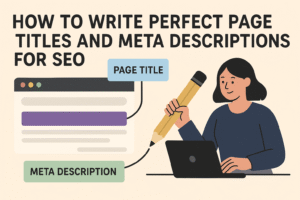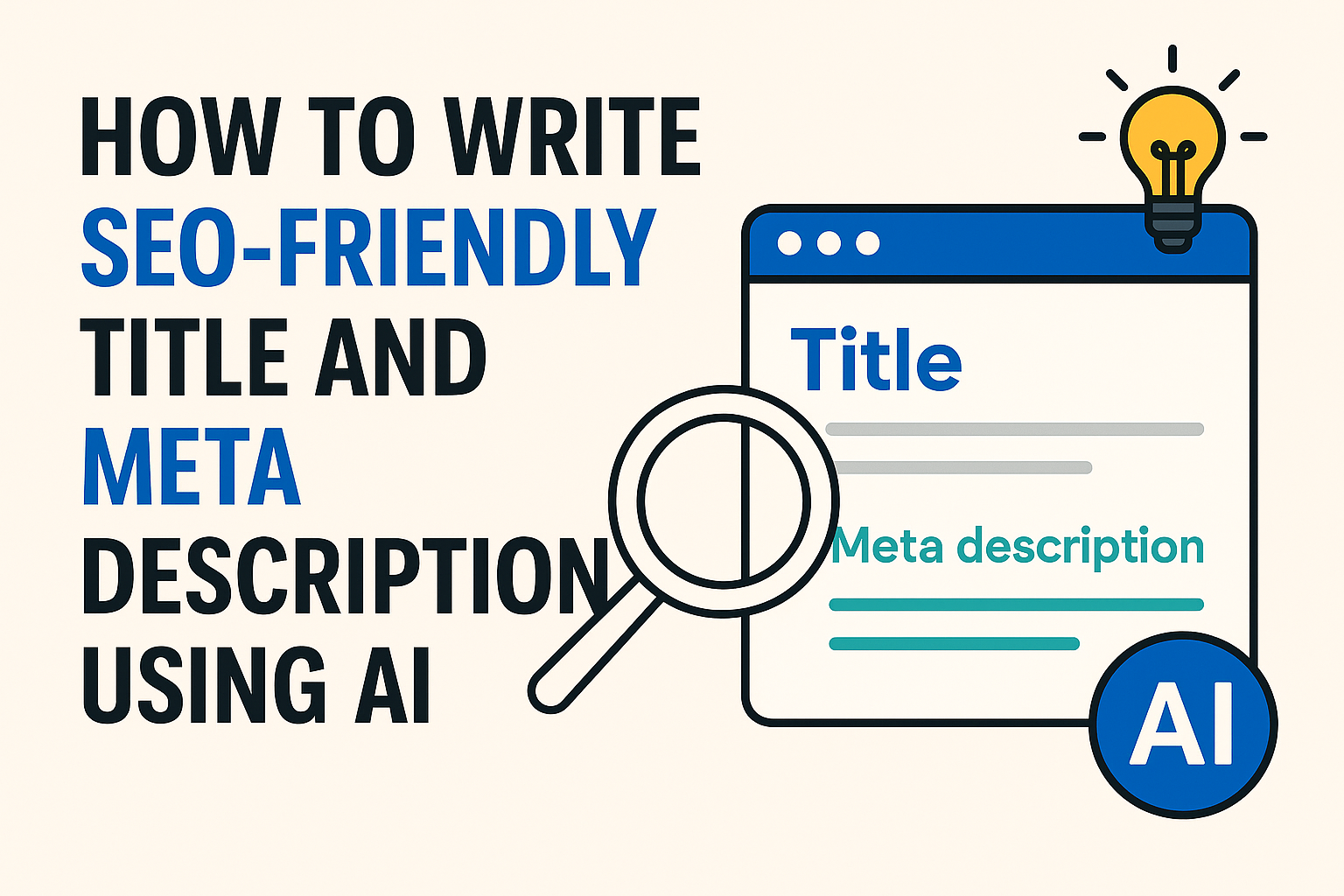 How to Write Perfect Page Titles and Meta Descriptions for SEO
How to Write Perfect Page Titles and Meta Descriptions for SEO
In the world of digital marketing and search engine optimization (SEO), the page title and meta description are often the first impressions that potential visitors get of your content. These elements play a significant role in determining how your website ranks on search engines and how likely it is that users will click through to your page. Crafting effective titles and meta descriptions is essential for driving traffic to your website, and this process can be optimized with best practices and the help of AI tools. In this article, we’ll walk you through how to write perfect page titles and meta descriptions for SEO.
1. Understanding the Importance of SEO Page Titles and Meta Descriptions
Before we dive into the mechanics of writing SEO-friendly page titles and meta descriptions, it’s important to understand their role in SEO.
Page Title:
- The page title (also known as the title tag) is the clickable headline that appears in search engine results and browser tabs.
- It serves as a summary of the content of your page.
- A well-crafted page title can help improve your search rankings and click-through rate (CTR).
- Search engines use the page title to determine the content’s relevance to a given search query.
- Meta Description:
The meta description is a short summary (150-160 characters) that provides a preview of what the page is about. - While it doesn’t directly affect rankings, it plays a significant role in influencing whether users decide to click on your link.
- A compelling meta description can improve your CTR, which indirectly helps improve your SEO.
2. Crafting SEO-Friendly Page Titles
Creating the perfect page title is more than just adding a keyword to the title tag. Here are the steps to follow to make your page title both SEO-friendly and user-friendly:
Step 1: Include Your Primary Keyword Early
The primary keyword you’re targeting should be placed as close to the beginning of your title as possible. Search engines give more weight to words that appear at the beginning of a page title.
Example:
Good: “SEO Tips for Beginners: A Complete Guide for 2025”
Bad: “A Complete Guide for 2025: SEO Tips for Beginners”
Step 2: Keep It Between 50-60 Characters
While there’s no exact character limit for titles, it’s recommended to keep your page title between 50-60 characters. Titles longer than 60 characters may get cut off in search results, which can affect visibility.
Step 3: Make It Engaging
Your page title should be compelling enough to grab the attention of users. Use action words or create curiosity around your content. Consider adding words like “Ultimate Guide,” “Complete Tips,” or “Proven Methods.”
Example:
“10 Proven SEO Tips for Beginners to Boost Your 2025 Rankings”
Step 4: Match Search Intent
Understanding the search intent of your target audience is key to crafting a relevant page title. Make sure your title directly answers the user’s query, whether it’s informational, transactional, or navigational.
Example:
Informational: “SEO Tips for Beginners in 2025”
Transactional: “Buy the Best SEO Tools for 2025”
Step 5: Use Branding (When Appropriate)
If you’re well-known or have a strong brand presence, you can consider adding your brand name to the page title. However, this is not always necessary unless it’s important for recognition.
Example:
“SEO Tips for Beginners – XYZ SEO Tools”
Step 6: Avoid Keyword Stuffing
While it’s important to include your keyword, don’t overstuff it. Your title should read naturally and make sense to the user. Avoid repeating the same keyword multiple times.
3. Crafting SEO-Friendly Meta Descriptions
Now that we’ve covered how to write the perfect title, let’s turn our attention to meta descriptions. A well-crafted meta description is a key element of on-page SEO because it influences users’ decisions to click on your link. Here’s how to write an effective meta description.
Step 1: Include Your Target Keyword
While meta descriptions don’t directly affect SEO rankings, search engines bold the keyword in the description when it matches the user’s search query. This draws attention and improves the chances of getting clicks.
Example:
“Learn the best SEO tips for beginners in 2025 and boost your rankings with proven strategies.”
Step 2: Be Between 150-160 Characters
Meta descriptions should be concise, usually between 150-160 characters, so they don’t get cut off in search results. This ensures users see the entire message, which can help influence their click-through decision.
Example:
“Explore essential SEO tips for beginners in 2025. Improve your rankings with our complete, easy-to-follow guide!”
Step 3: Make It Compelling
A good meta description should not only summarize the page content but also entice users to click. Use language that encourages action, such as “Learn how,” “Discover,” or “Get started.”
Example:
“Learn how to improve your SEO rankings in 2025 with 10 expert tips. Start boosting your traffic today!”
Step 4: Be Specific and Action-Oriented
Meta descriptions should briefly outline what users can expect from the page. Be specific and make sure to focus on the value users will get from reading the content. Also, include a clear call-to-action (CTA).
Example:
“Unlock the secrets to better SEO rankings. Read our top 10 SEO tips for beginners and start seeing results today.”
Step 5: Avoid Duplication
Each page should have a unique meta description that accurately reflects the content on that page. Avoid using the same meta description across multiple pages on your site.
Step 6: Align with Search Intent
Just like with page titles, your meta description should align with search intent. If the search is informational, make sure your description reflects that.
Example:
Informational: “Explore the latest SEO trends in 2025 and learn how to implement them effectively.”
4. Using AI Tools to Write SEO-Friendly Titles and Meta Descriptions
While writing SEO-friendly titles and meta descriptions requires understanding SEO principles, AI tools can assist in generating content more efficiently. Here are a few ways AI can help:
- Keyword Suggestions: AI tools like Jasper and Copy.ai can suggest keywords that are trending or have high search volume, helping you identify the best ones to include in your title and description.
- Template-Based Writing: Many AI tools offer title and meta description templates, making it easier to generate SEO-optimized text quickly.
- Content Refinement: AI tools can help refine your titles and descriptions to make them more engaging and keyword-optimized, saving you time in the process.
- Testing and Optimization: Some tools also offer A/B testing for titles and meta descriptions, helping you understand which combinations result in the best click-through rates.
AI Tool Examples for Title and Meta Description Writing:
- Jasper AI: Generate SEO titles and meta descriptions by inputting your topic and target keywords.
- Surfer SEO: Provides AI-powered recommendations for improving your titles and meta descriptions based on data-driven insights.
- Writesonic: Offers pre-built templates and AI-powered writing tools to help optimize your page titles and meta descriptions.
5. Best Practices for SEO Page Titles and Meta Descriptions
To make sure your titles and meta descriptions are fully optimized for SEO, keep the following best practices in mind:
- Write for Users, Not Just Search Engines: Although SEO plays a significant role, your titles and descriptions should prioritize user experience. Ensure they are engaging, easy to read, and relevant to the content.
- Focus on Search Intent: Understand what your target audience is searching for and craft titles and descriptions that directly align with that intent.
- Monitor and Test: Regularly check the performance of your titles and meta descriptions through tools like Google Analytics and Google Search Console. Testing different variations can help you optimize over time.
Conclusion
Writing the perfect SEO page titles and meta descriptions is essential for both ranking on search engines and attracting clicks from users. By following the best practices outlined above, you can create titles and descriptions that are both search engine-friendly and compelling to readers. With the help of AI tools, you can streamline the process of creating optimized content, ensuring that your pages stand out in search results and drive more traffic to your website.
Remember, SEO is an ongoing process, so regularly updating and refining your titles and meta descriptions can lead to long-term success in search rankings.

